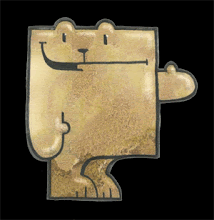Look at this...
Okay. This is, at the end of the day, just a load of dark marks on a lighter surface. They mean nothing in themselves. They are inert. They can be easily destroyed. They offer no life, no resistance, no fight.
Without your eyes and brain they are nothing. It is your skill as a sophisticated information processor that gives them any hope of validity at all. My camera has an amazingly good face recognition thingy, and can even pick out the happy people on advertising billboards, ( it sometimes even wants to read electric sockets and things as "faces" - like that Two Ronnie's optician sketch "No Sir, you're just reading the furniture now") but it just looks blank at me when I point the lens at my sketchbook. So, by my camera's estimation, I am not doing faces properly.
So who decides that the sketch above is a face ? More than that, a male face, wearing glasses and an open collared shirt ? ( which is what it's supposed to be by the way... just in case you are seeing a mongoose licking an oil drum or something !!! ) You do. The viewer. And as I have no control over how you see things, that makes my part in the interaction between you and it negligible. Yes ? No ?
What do you think ?



















Without you, there wouldn't BE an interaction. You provide the stimulus, regardless of our response!
ReplyDelete"And as I have no control over how you see things,..." I disagree. It is you that have begun the process by your choices of information to put on a page. As George says there would BE no interaction without the "cause" which is you.
ReplyDeleteI also think as the artist, we determine what is art and who the art is for....sometimes I sketch for myself to learn, sometimes to amuse myself and at other times with the audience, the viewer in mind. That's not to say the pieces I sketch to learn or amuse myself with would not also be suitable for an audience, but the intent is different....am I making any sense?
George has it in one. You are the prime mover. It is your selection of line and space that makes us see the face you want to see.
ReplyDeleteThe viewers interpretation of your drawing does have significance in the dialog between you and them, but it is the artist who provides the initial insight that acts as a springboard towards that interpretation.
ReplyDeleteThis touches on the reason that I try very hard not to use illustrations as reference material. The original artist has already interpreted whatever the object was, lets say a mongoose licking an oil drum. My interpretation further distills it from what it originally was.
Good thought provoker Keith. Where to start? At the start I guess.
ReplyDeletePedantic maybe - but not a contract. Contracts are ties, chains. I have to comply with a contract. What I have with the artist is a relationship. But one that is much looser than a contract. I'm free to interact with it.
I agree with Laure and others that you do have some control over how I see your invention. You set the parameters. You may not have much conscious control over how you see the subject in the same way that I am confined by bits of biology, chemistry, psychology (together as a system)to see what I see. It's not a deliberate conscious act. It just happens. BUT I am not a camera. Your camera is stupid. Sorry not meaning to offend - don't tell it will you? But your camera is a simple mechanical system designed to react to certain stimuli. Some might say that so are humans. But they'd be wrong. We are, however constrained. Yes we could see the mongoose - but by and large we don't - we see the bloke's face (which looks like Simon Caulkin - who? Another time.)We can't help it. We may want to see a mongoose but we see a face. It's not a conscious decision, we just do. Your part in the interaction, however hard you try to evade responsibility, is essential. Some would, indeed, have said "cause". You brought the invention into being. You conversed with reality and presented us with your version of reality (your invention) - we in turn converse with your invention. It would not exist without you, and from my point of view it would not exist (to me) without me. Causality is not necessary linear. Can the causer be caused by the caused/causee? That probably sounds a bit mad - but the idea of a relationship maybe explains it better. You relate to the subject and produce the drawing. I relate to the drawing and through it to you - and through you to the subject of the drawing even if it's your recreation of the subject. There's more but I must rush out into my garden and shoo the mongoose away from my oil drum.
My head hurts.
ReplyDeleteSimilarly,you are the inventor and originator of your head pain. The head pain would not exist if you:
ReplyDeletea)did not have a head; b) had not started this 'line' of discussion (maybe best to consign to a metaphorical drawer - a 'line in a drawer'?); c) did not exist to have a head nor pain in it; did exist but as a mongoose licking an oil drum.
Oh no, I'm not letting this one go for a while. So........
ReplyDelete